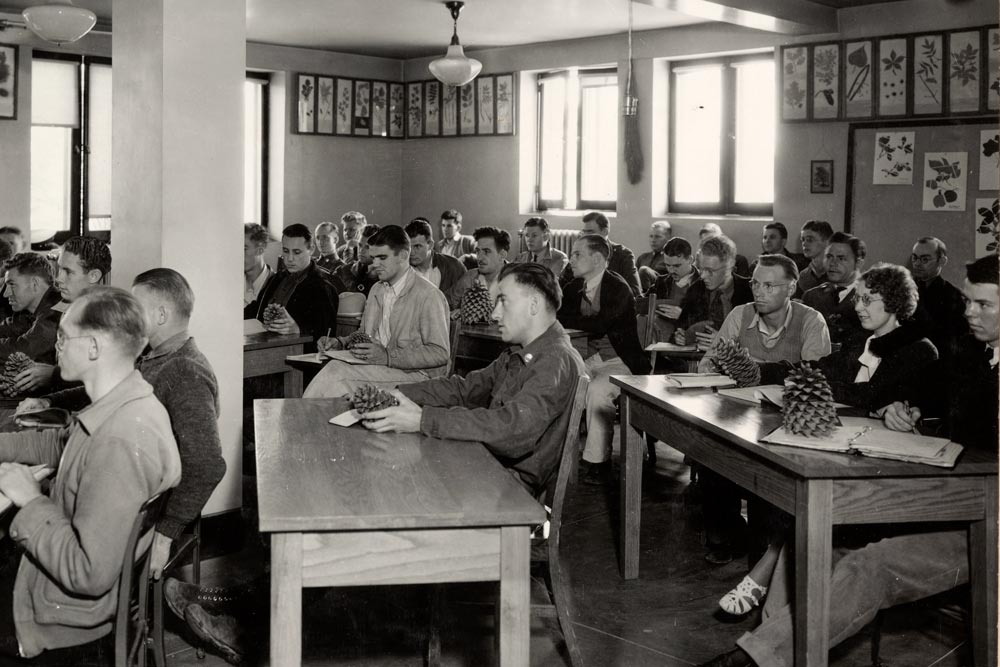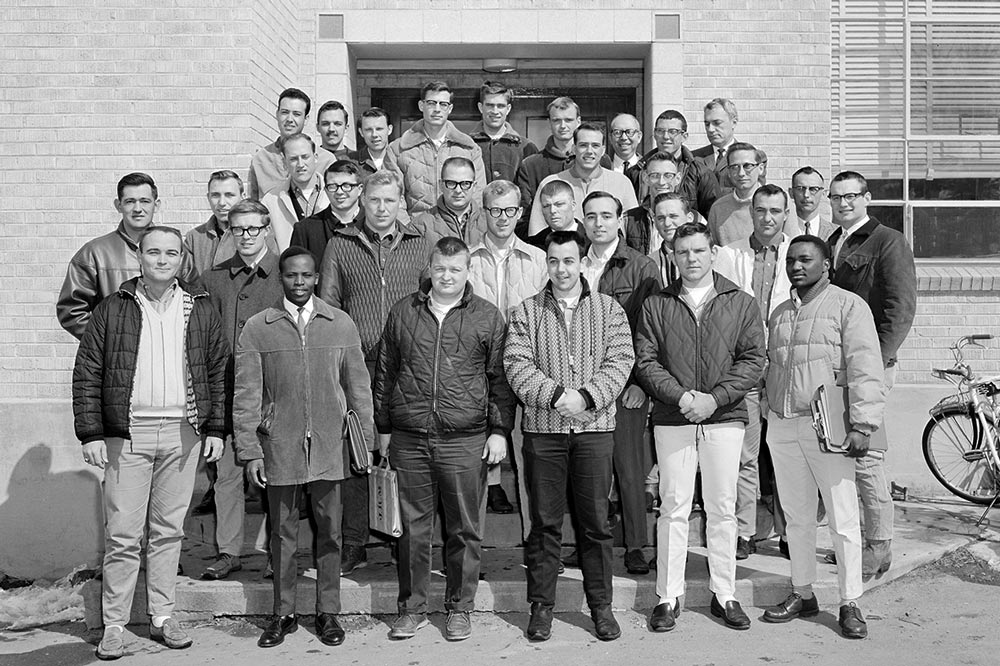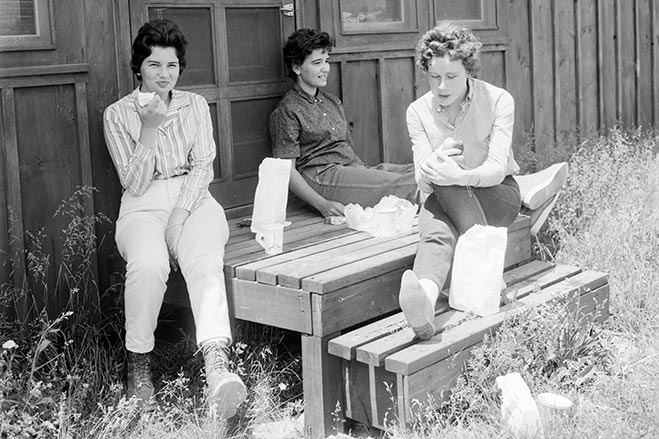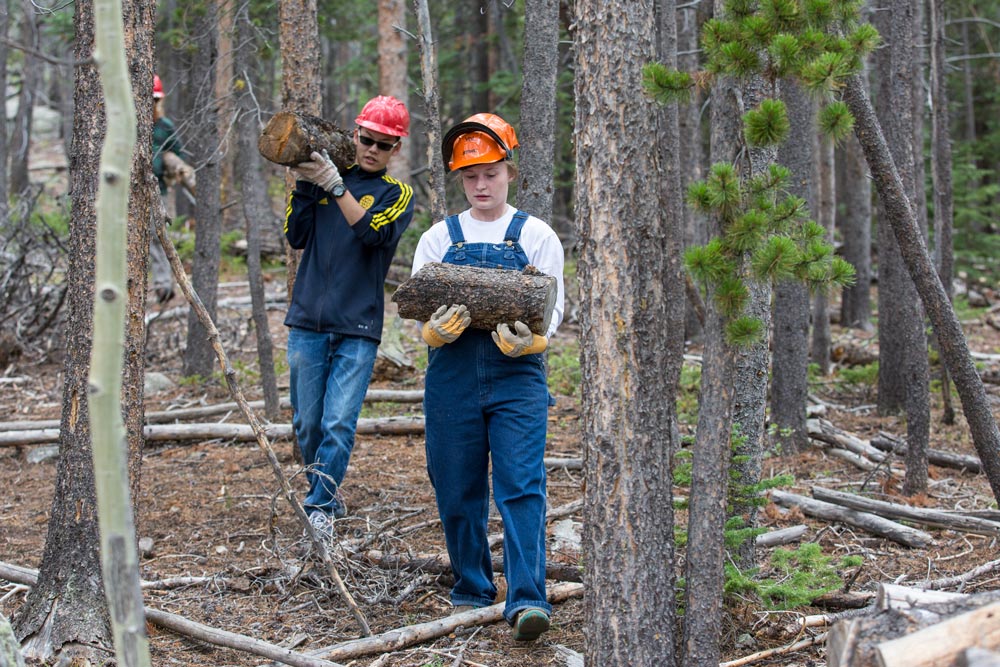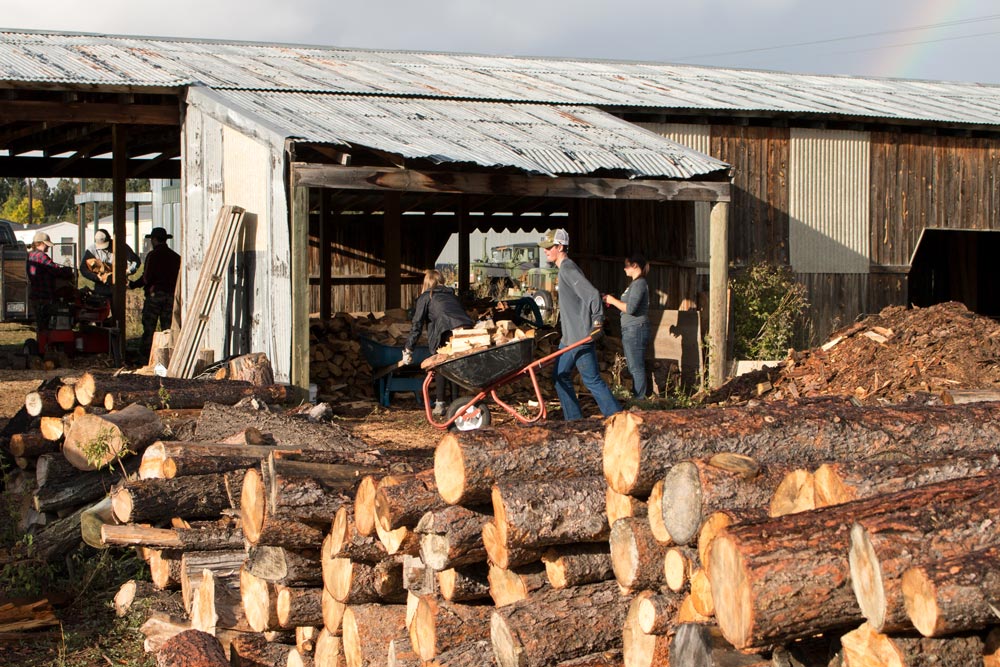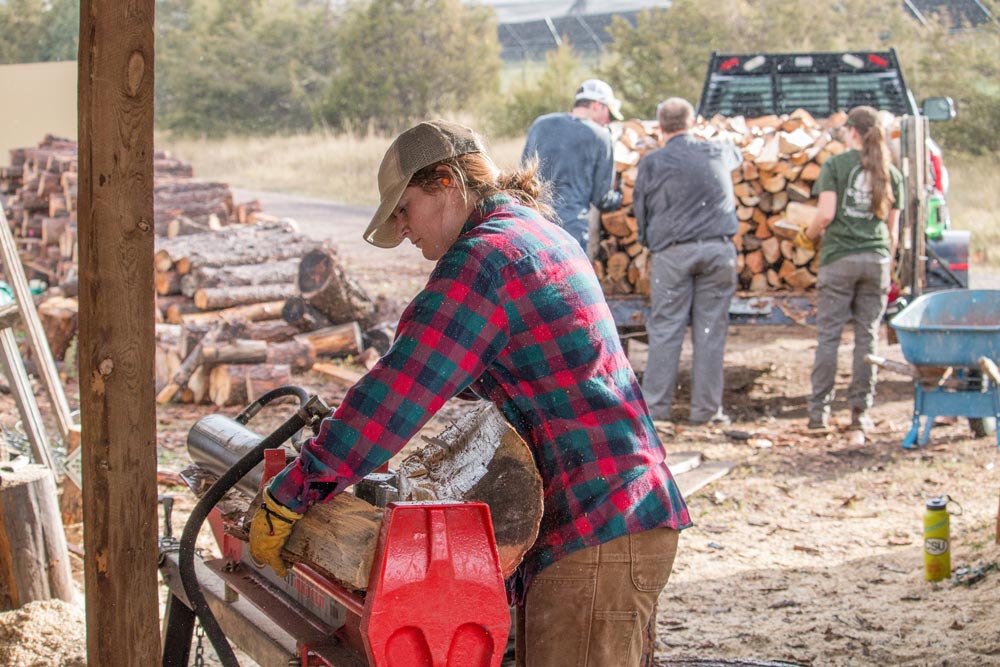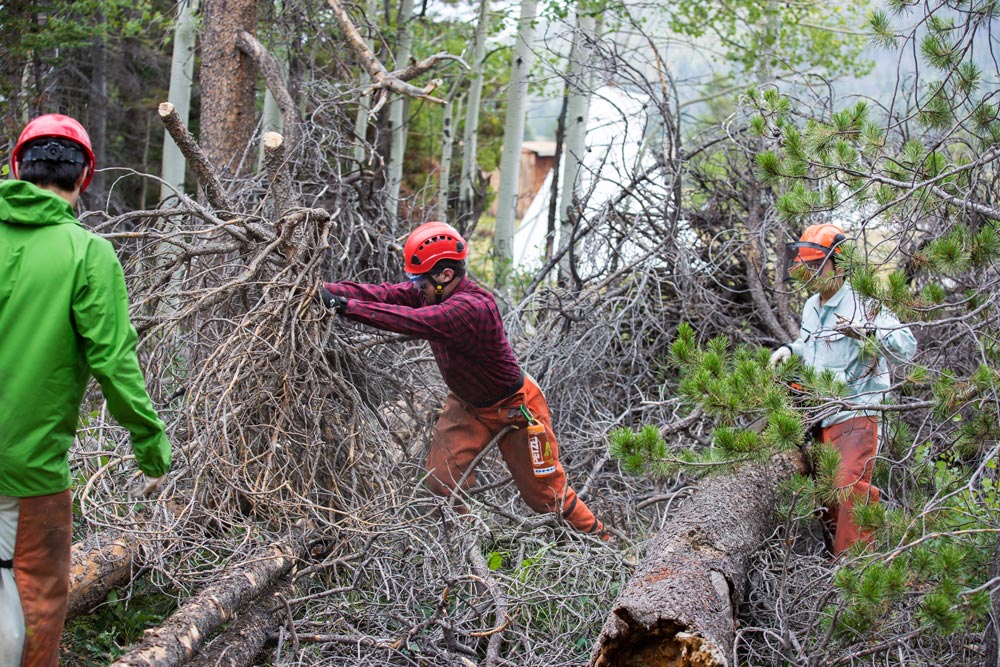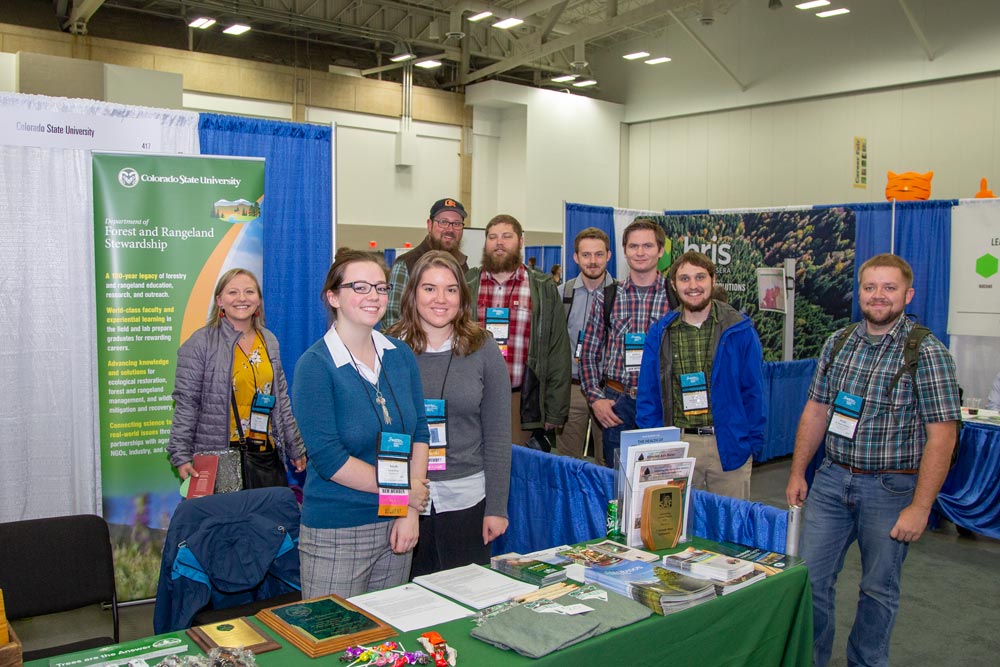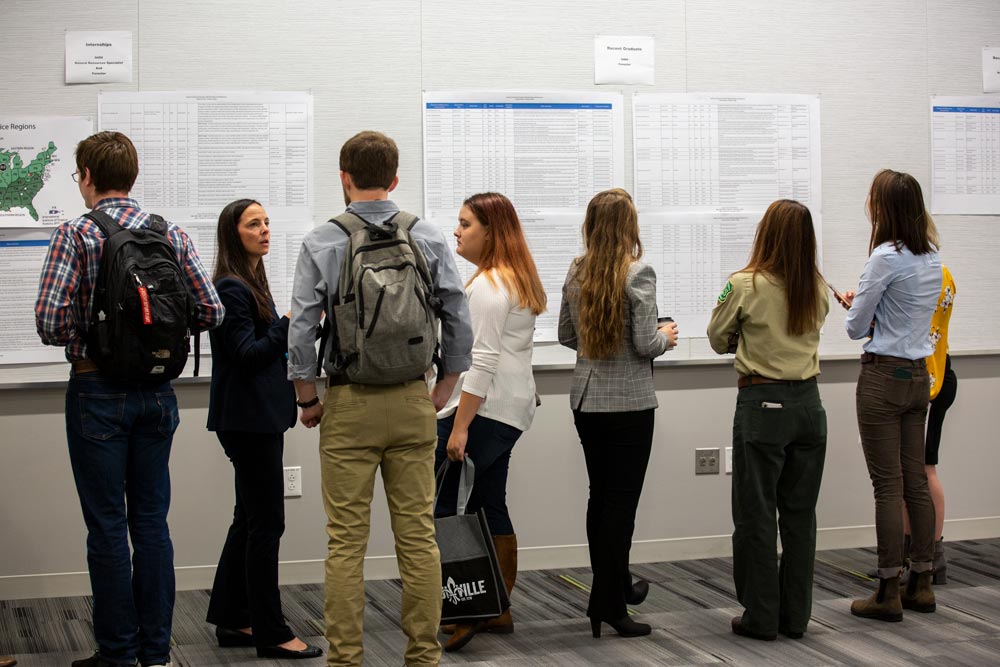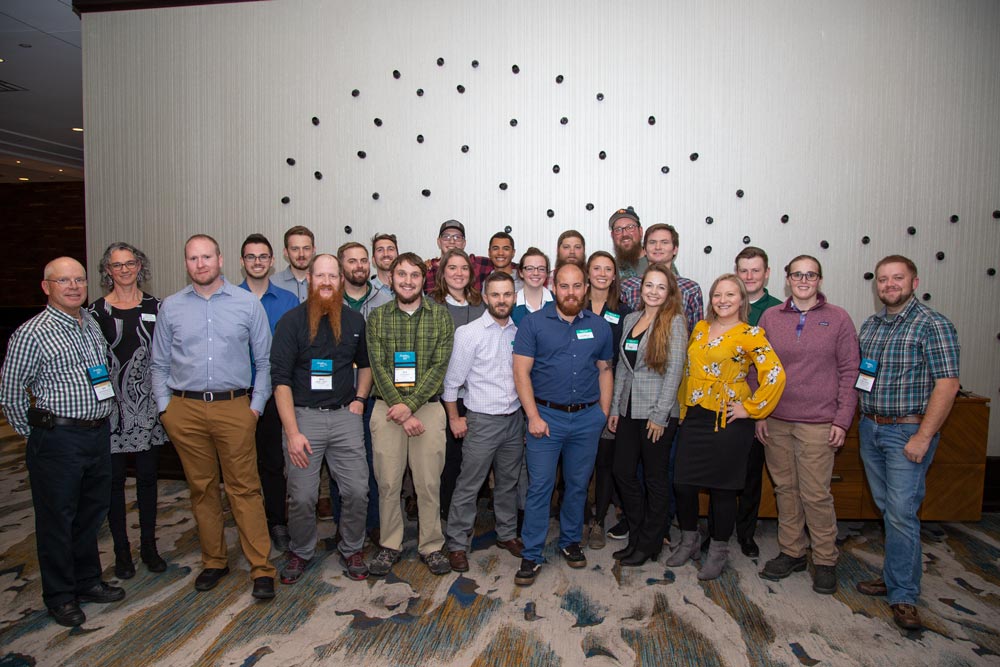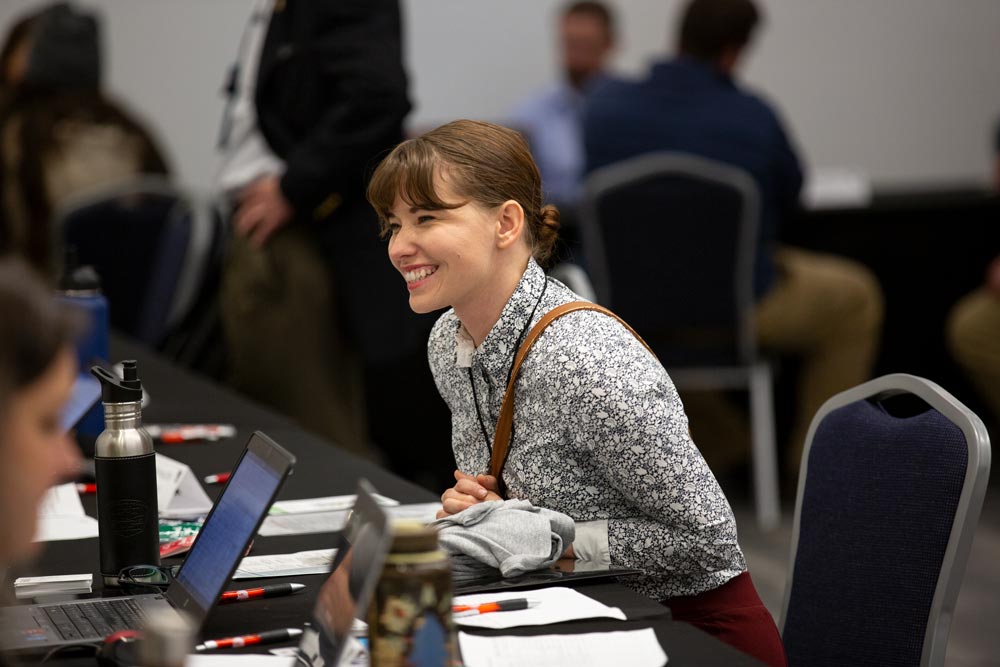A FORESTRY LEGACY
CONNECTS GENERATIONS
by Karina Puikkonen
There’s something you need to know about forests.
They change.
Year after year, saplings reach toward sunlit sky with protection from the mature canopy trees above. When they are strong enough to stand and large enough to shield, they become part of the canopy too and begin adding to the collective strength of the forest. The cycle renews.
Forests persist and adapt. It’s a beautiful natural cycle and a fitting metaphor for the people who have built Colorado State University’s forestry legacy. Forestry students, alumni, faculty, and staff, honor 20th century roots while being stewards of progress.
Fall 2019 marks the 50th anniversary of the Society of American Foresters (SAF) Alpha Chapter. The Alpha title designates a milestone for both the university and a professional society that advances the sustainable management of forest resources. CSU Alpha was the first SAF student chapter in the nation.
The Alpha seed rooted in the good ground of CSU’s enduring forestry program. Luminaries of this legacy stand among student saplings rising to join them as pillars in this specialized field. While following the well-trodden path their forbearers laid, students in the Alpha chapter also recognize they must blaze their own way in a rapidly changing climate.
Forestry generations intersect
Little did Erik Frey know who he would be rubbing shoulders with when he stepped into the halls of his first SAF national convention in 2017, a brand-new experience for the recent CSU transfer student.
This gentle giant from Omaha, Nebraska didn’t have experience in the natural world when he first began studying film and video production in college in 2006, but a photography assignment in a local forest changed all that. After the class ended, he continued hiking there almost every weekend for several years while his friendly demeanor paid the bills as a commission-based IT salesman. Over time, he witnessed how beavers ultimately transformed a dry area into a lush, green wetland full of life.
“Seeing what one species of animal could do to improve an entire landscape made me realize that’s what I wanted to do with my life too,” Frey said.
So, in 2017 Frey found himself assessing the lay of the land at the SAF national convention. While his new group of SAF Alpha peers were celebrating a first-place Outstanding Student Chapter award, another award made a lasting impression on him.
That year, Tom Thompson, a 1968 CSU forest management graduate, received the Gifford Pinchot Medal, the highest honor SAF awards forestry professionals. For Frey, everything clicked. The student who would become SAF Alpha president for the 2018-2019 academic year began to see his future.
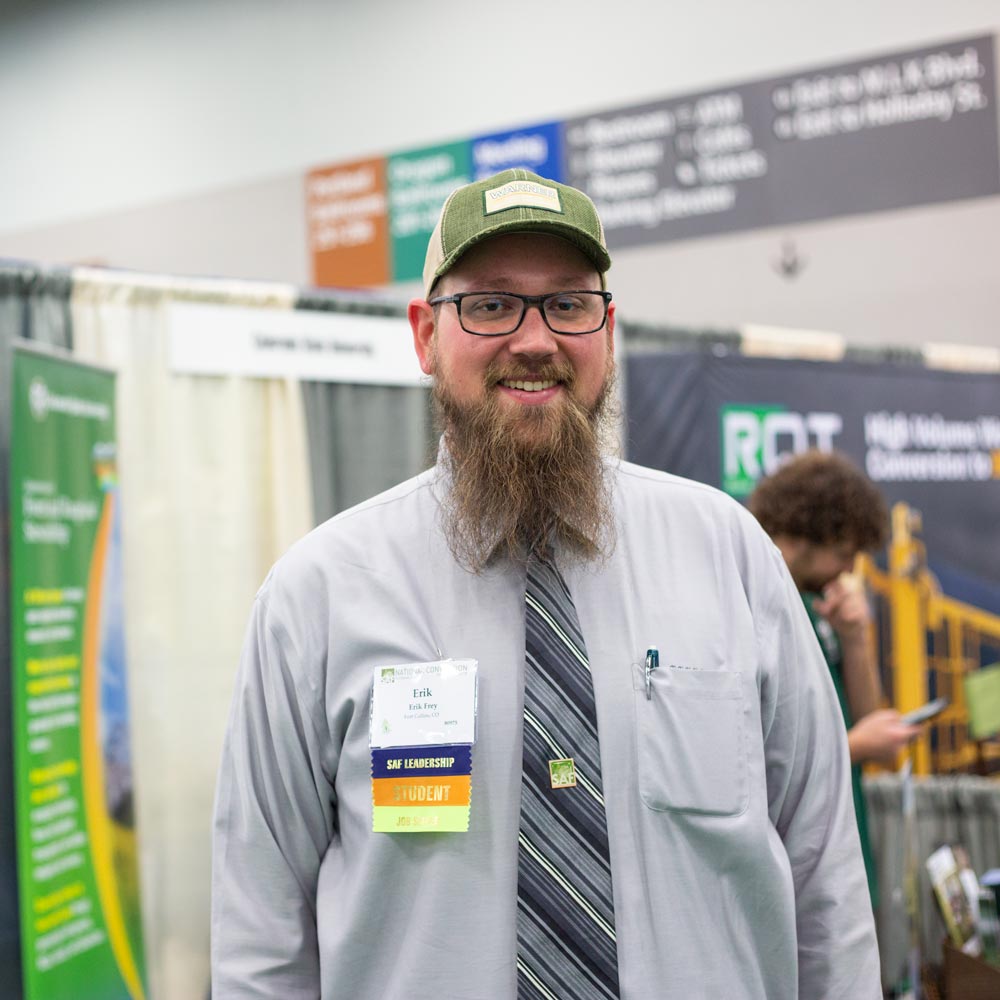
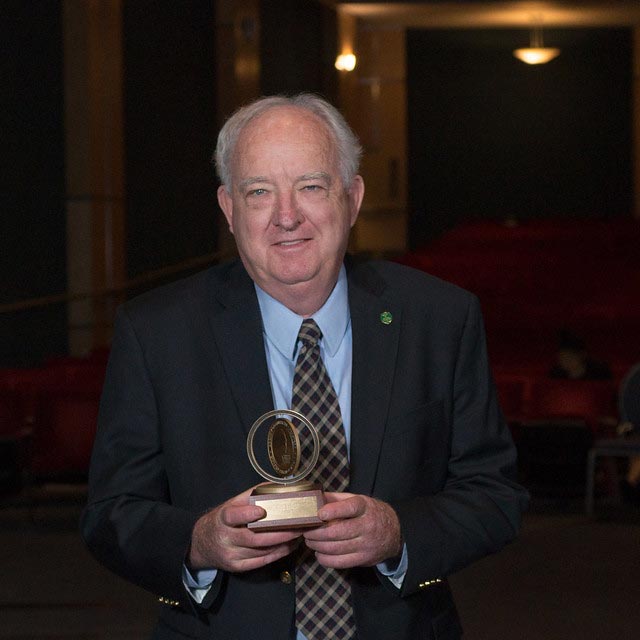
Conversely, Thompson was celebrating his past. After graduating from CSU, he took a job with the USDA Forest Service in Alaska and never looked back. Thompson eventually became the Deputy Chief of the public agency and oversaw the management of 193 million acres of land nationwide – an area the size of Texas.
After retiring with 37 years of public service in 2005, Thompson has branched out within the forestry profession. He has been active in SAF leadership positions including a year as the society’s national president. Closer to home in Colorado, he currently sits on CSU’s Warner College of Natural Resources Dean’s Council. His is a life still dedicated to forestry.
“Keep trying to make a positive difference and improve the organizations you’re working for, no matter what it is.” Thompson said. “I always felt that you should be learning more and pushing yourself to do more which ultimately makes room for others to come in behind you to learn and excel.”
Space and time intersected for CSU’s forestry program in 2017. SAF Alpha had earned the top student award three out of the previous four years thanks to alumni such as Thompson. Fifty years earlier, he and his own group of peers had the foresight to appeal for the first student chapter in their professional society. Through mentorship and group support, Thompson helped establish the foundation of the forestry path that flagged the way for scores of others.
Planting the seed
Thompson attended CSU from 1965 to 1968 and served as vice president of what was then called the Forest Management Club his senior year. The club had goals of learning about forestry, meeting forest management professionals, and building up their college community much as they had in years before, but this group of members wanted something more.
They were members of the national SAF organization, and attended local Long’s Peak Chapter meetings of the Central Rocky Mountain SAF Section based in Colorado. Thompson remembers one local chapter meeting where the students and professionals finally realized they shared similar goals. Discussions began about forming a student chapter, something that had never been done before.
“It was a memorable evening,” Thompson recalled. “We saw that having a student chapter could provide more access and support for forestry students and more pride in our College of Forestry and Natural Resources.”
It wasn’t until the next year that the group’s novel idea turned into action. Faculty advisor Warren E. Frayer, an assistant professor in forest biometry at the time, guided the young campaigners in their grassroots efforts and became vital in pushing the idea to the national stage. The Long’s Peak Chapter assisted the students with developing an official organization complete with their own bylaws.
“I’d never seen a group of students so eager to get together like this,” Frayer said. “At first, SAF didn’t feel the need to add student chapters, but the students’ own preparation and persistence proved they were ready.”
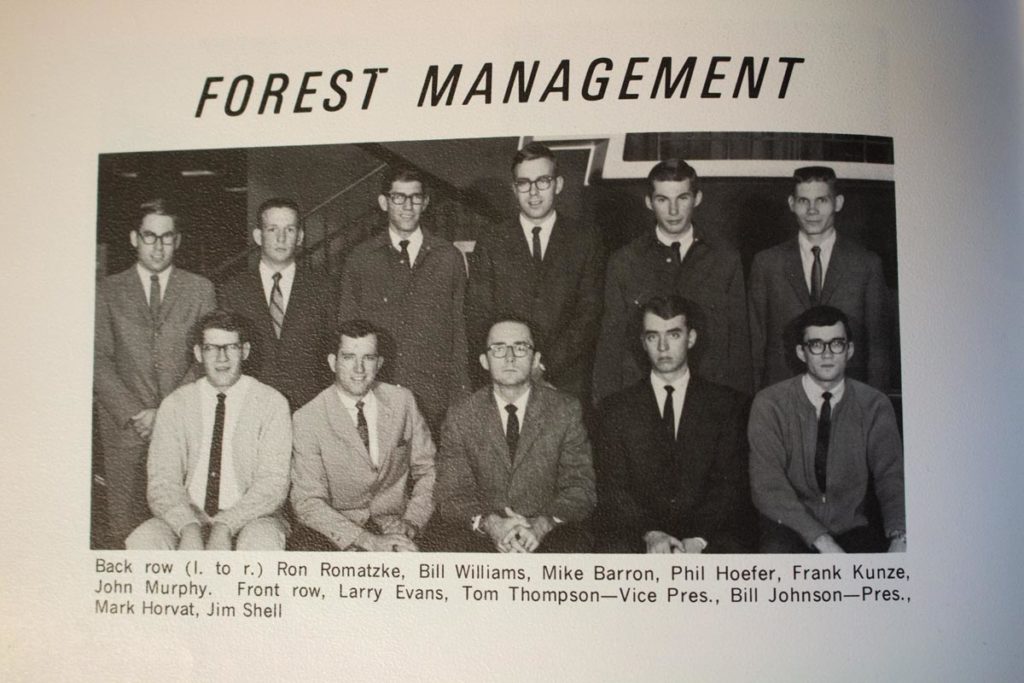
This new student-led entity formed under the tenets of SAF outlined in 1900 by the society’s first president, Gifford Pinchot, who was also the first chief of the U.S. Forest Service and known as the father of American forestry. The mission of this collective society, for students and professionals alike, was, and still is, to use knowledge, skills, and a conservation ethic to manage sustainable forests in perpetuity. Under this oath, more than 100 people attended the Alpha initiation ceremony at the Fort Collins Country Club on November 6, 1969.
The new SAF unit immediately began functioning as both official chapter and student club under the leadership of forestry students Joseph Stancar, Delwin Beck and Stephen Ambrose. Student members joined local and state committees and found a voice within the organization. CSU was soon followed by Stephen F. Austin State University, and now over 60 student chapters dot university and community colleges across the nation.
CSU forestry legacy
Students have been at the heart of CSU’s forestry tradition since its origins at the beginning of the 20th century. In 1904, the first forestry class was established at the Fort Collins institution originally founded as the Colorado Agricultural College (CAC).
The class was the state’s response to an impassioned paper titled “The Importance of a Forest School in Colorado,” published earlier that year by William Stone of the Colorado Forestry Association. Demand for wood from the Rocky Mountains skyrocketed as towns and cities suddenly appeared across the open land of the young state. Stone grieved at the rate in which these forests were being lost, stating that planting and repairing wooded lands needed “men” skilled in forestry, but there were few of these to be found.
After the first four-year student graduated from the CAC forestry program in 1912, it quickly grew in student numbers, academic offerings, and reputation for excellence. From the 1920s until the 1960s the college, eventually renamed Colorado State University, and its forestry school became known as the “Ranger Factory.” Its training ground produced graduates that secured many posts in the fledgling National Park Service and occupied more positions in the U.S. Forest Service than any other academic institution.
The first Forestry Club formed early in the program’s existence. By 1916, students were already seeking additional resources to advance their forestry skills and bolster camaraderie. The club’s membership, predominately male for the next 60 years, fluctuated during each World War and the Great Depression. World War II opened up new opportunities for women and underrepresented populations to pursue natural resource fields. In times of peace and plenty, their presence helped the program and club become one of the largest independent organizations on campus.
For decades, the club organized a “Foresters Days” event that became the template for how CSU Alpha still functions today. Students invited professionals from across their field to give technical presentations, held society business meetings, conducted public outreach, offered field demonstrations to practice and share forestry skills, and hosted large social events for their community. By the late ’60s, this foundation ensured the club’s smooth conversion into an official unit of SAF. Engagement in their future profession became this group’s defining feature.
Prevailing in a new century
CSU Alpha’s goals still put continual emphasis on professional development much as before, but with a 21st-century twist. While Thompson and his peers brought students to the professional society, the chapter’s recent goals have as much to do with bringing the professional society back to the students. As for Frey, natural resource careers tend to be discovered careers, so he understands the value in helping students find them and their professional societies.
“My experience at the 2017 convention was a turning point for me, and really showed me the direction I wanted to go in forestry,” Frey said. “I wanted other students to have that same experience.”
His first goal as Alpha president was to get a record number of students to the 2018 SAF convention in Portland, Oregon. The funds were available, thanks to the chapter’s traditional firewood and holiday tree sales the previous year; Frey just needed the students. His campaign began at the Mountain Campus last summer, by sharing what he calls “the good news of forestry” with peers over a campfire or on cabin porches. Alpha Chapter’s recruitment efforts continued into the school year and bore fruit. More than 30 undergraduate students attended the SAF convention, most likely a record, according to experienced advisers and alumni. Attendance continued to be high this year as many undergraduate CSU forestry students made it to their first SAF convention in Louisville, Kentucky last week.
For one of those students, the 2018 convention became another turning point. Marley Smith, the SAF Alpha secretary, was one of the students Frey originally convinced to be part of the chapter. An internship in Hawaii had solidified the desire for this senior of Hawaiian descent to pursue forestry, but she was unsure if, and how, she would feel a sense of belonging in a field historically populated with white men.
“At first I didn’t feel that my opinions and values were appreciated,” Smith recounted. “It was hard for me to find the connection, but I had the desire to generate change and bring new perspectives into the field.”
She’s doing just that. Becoming a Student Diversity Scholar at the convention enabled her to participate in a series of activities focused on the topics of encouraging more diversity among people and career options in her field. Smith, who is also a USDA Forest Service Student Ambassador, isn’t afraid of speaking up. While active in this new conversation for the Society, she’s still waiting for action. Surrounded by a group of people with the same goal propels her to make that happen.
“I’ve met mentors who are changing my life and I’m developing lifelong academic and professional relationships,” she said. “I have a voice in a national organization, and others have reached out to me because they’ve faced similar situations.”
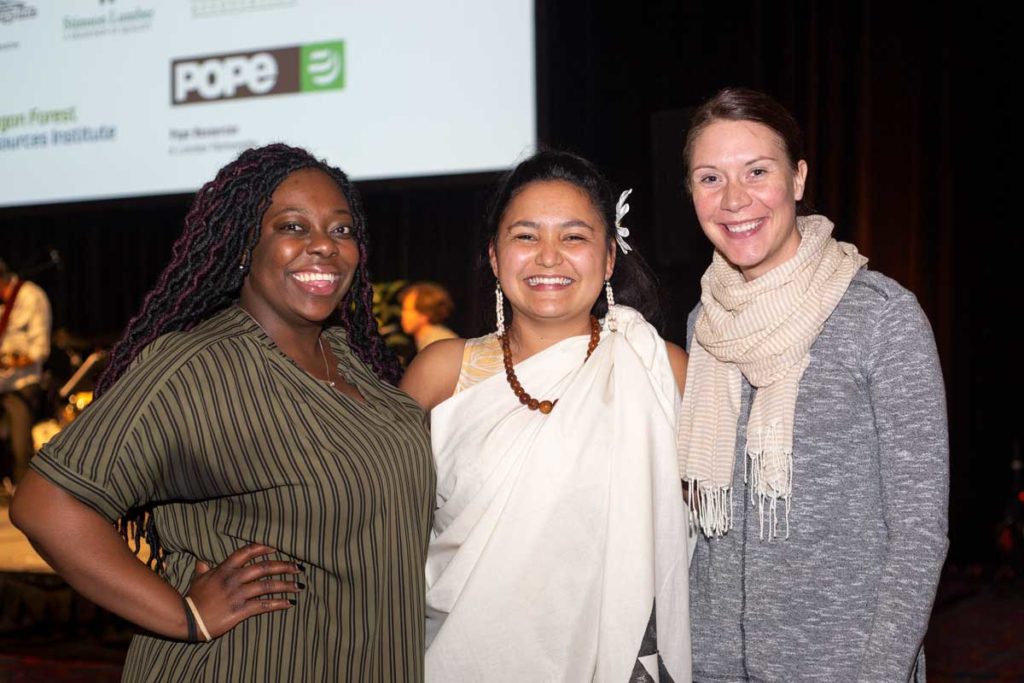
SAF is taking new steps to improve diversity and inclusion in their organization and overall field. The Society’s diversity and inclusion policy states that “successfully engaging people with diverse backgrounds and perspectives strengthens our communities, provides essential resources, and creates thriving forests.” There is mutual understanding across natural resource fields that maintaining the nation’s lands, wildlife, waterways, and soil will rely on the individual and collective efforts of a diverse nation.
Times have changed in political and natural environments over the last 50 years. Issues of equality are shifting the national conversation at the same time forest health, wildfires, and climate change are transforming forests in the West. SAF Alpha members are confronting these new environments as they enter their professions, and the group is focusing on growing more diverse opportunities to develop and inspire this new generation.
“SAF Alpha is a student club that students originally wanted,” Frey said. “It has made the future tangible, something we can all touch. We’ve all been in it for a greater cause, rooting for each other to succeed.”
Just like a forest.

